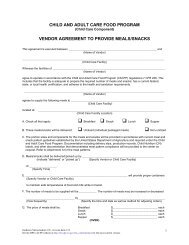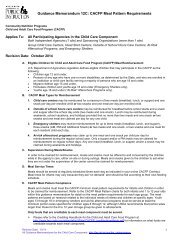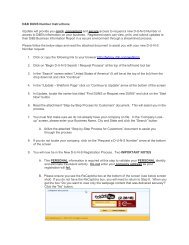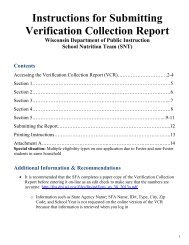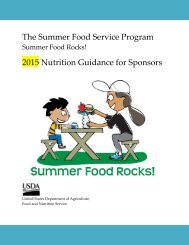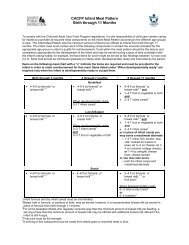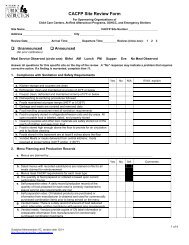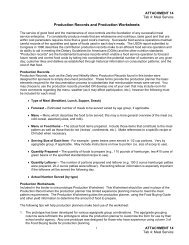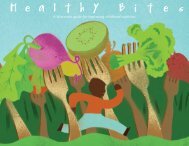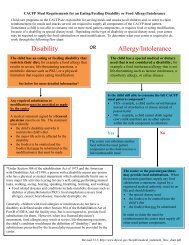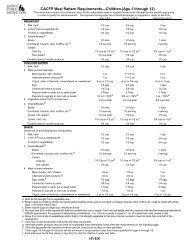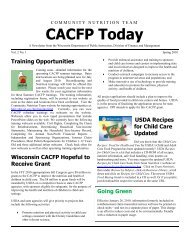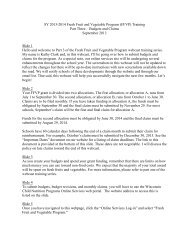The Food Allergy Book: - Indiana Department of Education
The Food Allergy Book: - Indiana Department of Education
The Food Allergy Book: - Indiana Department of Education
- No tags were found...
You also want an ePaper? Increase the reach of your titles
YUMPU automatically turns print PDFs into web optimized ePapers that Google loves.
<strong>The</strong> <strong>Food</strong><strong>Allergy</strong> <strong>Book</strong>:What School Employees Need to Know
<strong>The</strong>NEA HealthInformation Network (NEAHIN) is the non-pr<strong>of</strong>it health andsafety arm <strong>of</strong> the National <strong>Education</strong>Association (NEA). <strong>The</strong> NEA is the nation’slargest independent membership and laborassociation, representing more than three millioneducation employees. Since 1987, NEA HIN hasprovided information, programs, and services to NEAmembers throughout the U.S. and on military basesacross Europe and Asia. <strong>The</strong> mission <strong>of</strong> NEA HINis to improve the health and safety <strong>of</strong> the schoolcommunity by developing and disseminatinginformation and programs that educate andempower school pr<strong>of</strong>essionals andpositively impact the lives<strong>of</strong> students.This project has been funded at least in part with Federal fundsfrom the U.S. <strong>Department</strong> <strong>of</strong> Agriculture. <strong>The</strong> contents <strong>of</strong> thispublication do not necessarily reflect the view or policies<strong>of</strong> the U.S. <strong>Department</strong> <strong>of</strong> Agriculture, nor does mention <strong>of</strong>trade names, commercial products, or organizations implyendorsement by the U.S. Government.
<strong>The</strong> fourth-grade class atShadyside Elementary ishaving a birthday party.Selena just ate a cookie broughtinto the class by the parent <strong>of</strong> one<strong>of</strong> her classmates. All <strong>of</strong> a suddenshe notices a rash and hives on herarms. She begins to feel short <strong>of</strong>breath, so she lets Pam theParaeducatorknowthatsomethingis wrong.Continues on next page
INTRODUCTIONSelena the StudentContinued:Pam thinks that Selenamight be having anallergic reaction.Do you know whatPam should do?This booklet will giveyou information onwhat to do when astudent is having asevere, life-threateningallergic reaction andwill explain how youcan help preventreactions in yourschool.This booklet explains whatyou, the school employee,need to know about foodallergies and allergic reactions at school.• What are the most common foodsthat might trigger an allergic reaction?• What are the signs and symptoms<strong>of</strong> a severe, life-threatening allergicreaction?• What is anaphylaxis?• What is your role in helping tomanage food allergies in schools?Approximately six million children in theU.S. have one or more food allergies, andamong children with food allergies, 16-18%have experienced a reaction at school. Atany time, school staff may need to respondto a food allergy emergency—whetherin the classroom or cafeteria, or on theplayground, athletic field, or school bus.That’s why it’s important for you to knowabout food allergies and understand yourrole in helping to prevent and respond toallergic reactions in schools.4
What is a <strong>Food</strong> <strong>Allergy</strong>?<strong>Food</strong> allergy is an abnormal response to afood, triggered by the body’s immune system.In individuals with food allergies, the immunesystem mistakenly responds to a food(known as the food allergen) as if it wereharmful, triggering a variety <strong>of</strong> negativehealth effects. Some food allergies can beoutgrown, but some are lifelong; there isno cure for food allergies. Strict avoidance<strong>of</strong> the food allergen is the only way toprevent a reaction.Common <strong>Food</strong> AllergensMore than 170 foods are known to causea reaction in some people; however, eightfoods account for 90% <strong>of</strong> all allergic reactionsto food. <strong>The</strong>y are:• milk• eggs• peanuts• soy• wheat• tree nuts (e.g., almonds, walnuts, pecans)• fish• shellfish (e.g., crab, lobster, shrimp)While these eight allergens are the mostcommon, a student may have a severe, lifethreateningallergy to a different food, andthey may be allergic to more than one food.FACT:4 out <strong>of</strong> every 100U.S. children havea food allergy.Did youknow?88% <strong>of</strong> schoolsreported that they hadone or more studentswith a food allergy.5
Unexpected food allergens can be found innon-food items such as:• modeling clay and paper mache(may contain wheat)• crayons (may contain soy)• shaving cream (may contain milk)• finger paints (may contain milk oregg whites)• soaps (may contain wheat, dairy, soy,or nut extracts)<strong>Food</strong> <strong>Allergy</strong> vs. <strong>Food</strong>IntoleranceDid youknow?<strong>The</strong> first time aperson is exposedto the food they areallergic to, they maynot show symptoms.It <strong>of</strong>ten takes additionalexposure to triggera reaction and havesymptoms appear.<strong>Food</strong> intolerances, such as lactose intolerance,are <strong>of</strong>ten confused with food allergiesbecause both can result in cramps, nausea,vomiting, diarrhea, or other gastrointestinal(GI) symptoms. <strong>Food</strong> intolerance involvesthe digestive system, while a food allergyinvolves the immune system. <strong>Food</strong>intolerances are generally not life-threatening,unlike food allergies, which can cause severe,life-threatening reactions. It is important thatfood allergies are diagnosed by a doctor.Signs and Symptoms <strong>of</strong> anAllergic ReactionAllergic reactions vary from mild to severeand can appear within minutes to hours afterexposure to a food allergen. Reactions canaffect one or more systems in the body, suchas the skin, gastrointestinal (GI) tract, and6
espiratory or cardiovascular system. Whilethe majority <strong>of</strong> severe reactions occur whenfood allergens are eaten, skin contact andinhalation also can cause a reaction, althoughthese reactions are usually less severe.Signs and Symptoms <strong>of</strong> anAllergic Reaction to <strong>Food</strong>Affected SymptomsBody SystemSkinSwollen lips/tongue/eyes, itchy/flushedskin, rash, hivesGastrointestinal TractCramps, nausea, vomiting,diarrhea, refluxRespiratory SystemWheezing, coughing,shortness <strong>of</strong> breath,trouble breathing, red/watery eyes, troubleswallowing, sneezing,hoarse voice, nasalcongestionCardiovascular SystemPale or blue skin color,weak pulse, dizziness,fainting, confusion,shock, drop in bloodpressure, loss <strong>of</strong>consciousness7
Did youknow?25% <strong>of</strong> anaphylacticreactions at schoolinvolve studentswhose allergy wasunknown at the time<strong>of</strong> the reaction.FACT:Anaphylaxis mayalso be caused byother allergens suchas medications, latexexposure, and bee orother insect stings.Be aware that children <strong>of</strong> different agesand developmental levels may communicatetheir symptoms in different ways. Childrenmay describe their allergic reaction by saying:• It feels like something is poking my tongue.• My tongue (or mouth) is tingling (or burning).• My tongue (or mouth) itches.• My tongue feels like there is hair on it.• My mouth feels funny.• <strong>The</strong>re is a frog in my throat; there issomething stuck in my throat.• My tongue feels full (or heavy).• My lips feel tight.• It feels like there are bugs in there(to describe itchy ears).• My throat feels thick.• It feels like a bump is on the back <strong>of</strong> mytongue (or throat).Source: <strong>The</strong> <strong>Food</strong> <strong>Allergy</strong> & Anaphylaxis Network,<strong>Food</strong> <strong>Allergy</strong> News, Vol. 13, No. 2 [2003]Severe Allergic ReactionsAnaphylaxis is a severe allergic reactionthat happens quickly and may cause death.It may cause a student to stop breathingor experience a dangerous drop in bloodpressure. You cannot predict how severe astudent’s reaction will be based on previousreactions. Students who previously had only“mild” reactions can later have dangerousand even life-threatening reactions.8
Responding to AllergicReactionsWhile not all allergic reactions result inanaphylaxis, any reaction has the potentialto be life-threatening. All reactions shouldbe taken seriously and treated immediatelyaccording to the school’s emergency protocolsand the student’s individual plan. Neverdownplay the severity <strong>of</strong> a reaction, even ifthe symptoms appear mild. Allergic reactionsare unpredictable and can suddenly turnfrom mild to severe.Epinephrine is the primary treatment foranaphylactic reactions, and early administrationimproves the chances <strong>of</strong> survival and quickrecovery. During an anaphylactic reaction,epinephrine is injected into the thigh muscleusing a safe automatic device called an autoinjector.<strong>The</strong> medication rapidly improvesbreathing, stimulates the heart, reverseshives, and reduces swelling <strong>of</strong> the face, lips,and throat. It is important to administerepinephrine as soon as possible if anaphylaxisis suspected, especially when a school nurseor other licensed health care pr<strong>of</strong>essional isnot available to make an appropriate assessment.In approximately 20% <strong>of</strong> anaphylactic reactions,symptoms go away only to return one tothree hours later. When epinephrine isadministered, emergency medical servicesmust be notified and the student taken to9FACT:Immediate accessto epinephrineis essential inresponding to foodallergy emergencies.According to a 2006CDC study, more thanhalf <strong>of</strong> schools allowsome students withfood allergies to carryand self-administerepinephrine.What does yourschool allow?Some states havelaws that allowschools to keep anon-patient-specificsupply <strong>of</strong> epinephrinefor students withouta plan, or for otheremergencies.What does yourstate law allow?
Sally the School Nursehelps students manage food allergiesand is the chair <strong>of</strong> the food allergy teamat her school. Sally works with the districtfoodservice director and parents/guardians to get medical statementssigned by a doctor that meet USDArequirements for school mealaccomodations.She shares thisinformation withfoodserviceworkers,whilefollowingstudentconfidentialitypolicies.
the nearest hospital for further medical assistanceand observation. Never leave a student alonefollowing an anaphylactic episode.Managing <strong>Food</strong> Allergiesin Schools: It’s a TeamApproachManaging food allergies in schools is a teameffort involving all school staff, parents/guardians, and health care providers.Everyone—including teachers, paraeducators,nurses, health aides, custodial and maintenancestaff, security <strong>of</strong>ficers, bus drivers, foodservice workers, secretaries and clericalstaff, counselors, librarians and mediaspecialists, coaches, and administrators—plays an important role in ensuring that theneeds <strong>of</strong> students with food allergies are met.<strong>Food</strong> <strong>Allergy</strong> Managementand Prevention PlansSchools should create and implement foodallergy management and prevention plans (FAMPP)that address the daily management <strong>of</strong> foodallergies; emergency response; bullying <strong>of</strong>and discrimination against students withfood allergies; and education for staff,students, and parents/guardians.<strong>The</strong>se plans should be based on schooldistrict policy and implemented by a foodallergy management team or an existingSally the SchoolNurse Continued:Sally provides annualfood allergy trainingto all school staff sothey can recognizethe symptoms <strong>of</strong> anallergic reaction andknow how to respondin an emergency. Shekeeps auto-injectorsfor students withsevere food allergiesin a safe, secure,and easily accessiblelocation in her <strong>of</strong>fice.NOTE: Epinephrineis relatively safe,and its side effects,if administeredunnecessarily, areusually mild andtemporary.11
Tammy the Teacher implementsfood allergy lesson plans as part <strong>of</strong> theschool’s health education curriculumand makes sure students with foodallergies feel safe in her classroom.To help prevent exposure to foodallergens, Tammy enforces a “no foodsharing or trading” rule. When snacksarebroughtinto theclassroom,she reads all labelsfor potential allergens.12
health and safety team. Team membersshould represent various job categories,including (but not limited to) nurses, foodservice workers, custodians, counselors, busdrivers, and teachers or paraeducators.Check to see if your school has a FAMPPand a team that coordinates the implementation<strong>of</strong> the plan.Getting the RightDocumentationIn order to identify, monitor, and supportstudents with food allergies, parents/guardiansand the student’s doctor must work withthe school to document medical and dietaryinformation and develop individualizedfood allergy management strategies for theschool to follow.Individual Plans forStudents with <strong>Food</strong> Allergies<strong>Food</strong> allergies must be confirmed by thestudent’s doctor. Prior to the start <strong>of</strong> eachschool year, the student’s parents/guardiansshould provide the school with a signedstatement from a doctor. Medical and dietaryinformation should be included in thestudent’s food allergy Emergency Care Plan(ECP), also known as a <strong>Food</strong> <strong>Allergy</strong> ActionPlan, and may be included as part <strong>of</strong> a 504plan, Individualized <strong>Education</strong> Plan (IEP),and/or Individualized Health Plan (IHP).13Tammy the TeacherContinued:At the beginning <strong>of</strong> theschool year, and whenevera student withfood allergies joinsthe class, she informsall parents/guardiansabout classroom rulesand practices regardingfood allergies. Tammyis trained to respond t<strong>of</strong>ood allergy emergenciesand keeps ECPsand student-specificauto-injectors in a safe,secure, and easily accessiblelocation in herclassroom. She postshandwashing signs inher room and remindsstudents to wash theirhands properly usingsoap and water, beforeand after eating.
Parents/guardians <strong>of</strong> students with lifethreateningfood allergies may requestaccommodations for the daily management<strong>of</strong> their child’s condition under Section 504<strong>of</strong> the Rehabilitation Act <strong>of</strong> 1973, Title II<strong>of</strong> the Americans with Disabilities Act <strong>of</strong>1990 (ADA), and/or the Individuals withDisabilities <strong>Education</strong> Act (IDEA).TIP:Always follow yourschool’s proceduresfor handling foodallergy emergenciesas well as laws andregulations that guidemedication administration,storage, andaccess.School staff—including administratorsand foodservice, teaching, and healthpr<strong>of</strong>essionals—must share informationregarding life-threatening food allergiesand at the same time protect the privacy <strong>of</strong>student information. Schools and districtsmust conform to the Family <strong>Education</strong>alRights and Privacy Act (FERPA) and theHealth Insurance Portability and AccountabilityAct (HIPAA) when collecting, storing,and sharing personal student information.Emergency Care PlansEvery student with an identified food allergyshould have an individualized food allergyEmergency Care Plan (ECP) on file at school.ECPs are developed by the school nurse orthe student’s doctor and provide guidance forschool staff on handling food allergy emergencies.ECPs should be kept in safe, secure, and easilyaccessible locations and be shared with allappropriate school staff in accordance withstate and district policy.14
Pat the Principal knowsthat everyone—including teachers,paraeducators, custodial andmaintenance staff, security <strong>of</strong>ficers, busdrivers, food service workers, secretariesand clerical staff, counselors, librariansand media specialists, coaches, nurses,health aides, and administrators—plays animportant role in helping studentsmanage foodallergies inschools.20
Frank the <strong>Food</strong>service Workerhas a vital role in helping studentsmanage their food allergies atschool. He is trained on how to readfood labels, how to properly handleand store food, and how to separateequipment and utensilsto preventcross-contact.He readsevery foodand beveragelabel carefully,being sure to identifyevery ingredient.
ECPs should list:• the food allergen(s)• avoidance and prevention strategies• signs and symptoms <strong>of</strong> a reaction• severity <strong>of</strong> reactions and history <strong>of</strong>anaphylaxis• treatment plan for reactions• medication location and dosage instructions• assessment <strong>of</strong> the child’s readiness tocarry their own epinephrine auto-injector• any coexisting conditions that may affectfood allergy management (e.g., asthma)• dietary instructions and modifications• recent photo <strong>of</strong> the student• emergency contact information<strong>Food</strong> Allergies in SchoolNutrition ProgramsFrank the<strong>Food</strong>serviceWorker Continued:Frank knows whichstudents have foodallergies and whereECPs and auto-injectorsare located. He istrained on how toadminister epinephrine.Schools participating in USDA meal programsare required to make meal or food substitutionsor modifications for students whose allergiesare considered disabilities under USDAregulations. Under current USDA guidance,when a licensed physician includes in asigned medical statement that the student’sfood allergy may result in a severe, lifethreatening(anaphylactic) reaction, theallergy would meet the definition <strong>of</strong> a disability.<strong>The</strong> most current USDA guidance is available17
TIP:For questions aboutaccommodating astudent with a lifethreateningfood allergyin federal school mealprograms, contactyour state’s ChildNutrition Program.on the USDA <strong>Food</strong> and Nutrition website.USDA requires the following information inthe physician’s statement for all accommodationsin school meals:• the child’s disability• an explanation <strong>of</strong> why the disabilityrestricts the child’s diet• the major life activity affected by thedisability• the food or foods to be omitted from thechild’s diet, and the food or choice <strong>of</strong>foods that must be substituted<strong>The</strong> School Employee’sRole in Responding to <strong>Food</strong><strong>Allergy</strong> EmergenciesIn the event <strong>of</strong> a severe allergic reaction,school staff should follow their school’semergency protocols and the student’s ECP.<strong>The</strong> school nurse should be the firstresponder to a food allergy emergency.If allowed by state law, other school staff(including, but not limited to, health aides,food service workers, teachers, bus drivers,custodians, athletic coaches, and administrators)should be designated and trainedby the school nurse to respond in his/herabsence. All school staff should be trainedto recognize symptoms, to read ECPs, andto respond to food allergy emergencies,including the proper administration <strong>of</strong>18
Simon the Student knows how tocontact a school <strong>of</strong>ficial duringa food allergy emergency, andhe understands why it is wrong totease or bully students with foodallergies.25
Bert the Bus Driver knowswhich students who ride his bus havefood allergies. He attended anin-service training at his school on foodallergies and how to recognize thesymptoms <strong>of</strong> an allergic reaction andhow to administer epinephrine.
epinephrine, if permitted by law. In addition,all school staff should know which studentshave been prescribed epinephrine andwhere medication is located.It is important that you know how torecognize and respond to allergic reactions,because many students have undiagnosedfood allergies and experience their firstreaction while at school. In the absence <strong>of</strong>an individualized plan, you should alwayscontact emergency medical services immediately,even if epinephrine is administered.Schools should ensure that staff have accessto functioning intercoms, walkie-talkies, cellphones, or other communication devices inschools, on athletic fields, and on school buses,in case <strong>of</strong> an emergency. Bus drivers shouldbe trained on how to handle a food allergyemergency that occurs on the bus, includinghow to administer epinephrine (if allowed bystate law). <strong>The</strong>y also should know the emergencyroute to the hospital, in case emergencymedical services cannot be reached.Each food allergy emergency that involvesthe administration <strong>of</strong> epinephrine shouldbe documented and followed by a debriefingmeeting that includes the school staffand emergency responders involved. <strong>The</strong>student (where appropriate) and his/herparents/guardians should participate as well.Bert the Bus DriverContinued:To help preventexposure to foodallergens, Bert followsthe school districtpolicy on cleaning toremove food allergensand enforces a “n<strong>of</strong>ood”policy on his busunless a student hasspecial dietary needs.He uses a two-wayradio on his bus so hecan communicate withschool <strong>of</strong>ficials in theevent <strong>of</strong> an emergencyand knows theemergency route to thehospital in case emergencymedical servicescannot be reached.21
Courtney, a part-timesoccer Coach, is trained onfood allergy management and has a planfor responding to emergencies at homeand away games. She is trained on how toadminister epinephrine and brings studentspecificauto-injectors and ECPs to everypractice andgame.
Training and <strong>Education</strong>School StaffAll school staff should receive training onfood allergies and emergency response by theschool or district nurse. Invite the parents/guardians <strong>of</strong> students with food allergiesto be involved. <strong>The</strong>y can provide firsthandknowledge about their experience with foodallergies. Substitute teachers, coaches, volunteers,field trip chaperones, and appropriatecontract employees also should be trainedto respond to food allergy emergencies.StudentsTeachers and paraeducators should useclassroom lessons to teach all studentsabout food allergies. Students shouldunderstand the school’s food allergy policiesand practices, the signs and symptoms <strong>of</strong>anaphylaxis, how to contact a school <strong>of</strong>ficialduring an emergency, the food and nonfooditems that are common causes <strong>of</strong>allergic reactions, and why it is wrong totease or bully students with food allergies.Supporting Studentswith <strong>Food</strong> AllergiesStudents with food allergies need to feelsafe and secure. Creating a positive climateis a collective effort among administrators,school staff, students, and parents/guardians.23Courtney the CoachContinued:Courtney is alsotrained on how torecognize symptomsand understands howher players mightcommunicate them.She reminds parents/guardians regularlythat if they providea postgame snack,it must conform toschool and districtfood allergy policiesand be safe for all <strong>of</strong>her players.
FACT:A study <strong>of</strong> teens withfood allergies foundthat 24% reportedbeing subjected tosome sort <strong>of</strong> bullying,and that the majorityconsidered the bullyingto be directly related totheir food allergies.TIP:<strong>The</strong> school or districtnurse should provideinformation andtraining to parents/guardians on foodallergies, the school’sfood allergy policiesand practices, the role<strong>of</strong> school staff, andparental responsibilitiesin communicating withthe school about theirchild’s food allergy.Mental health pr<strong>of</strong>essionals—such as schoolcounselors, psychologists, and social workers—play a critical role in preventing bullying andensuring that students with food allergiesare not socially isolated. School staff shouldenforce state and district policies related tobullying and discrimination. Acts <strong>of</strong> bullyingand discrimination should never be tolerated.Preventing AllergicReactions in Schools<strong>The</strong> only way to prevent allergic reactions t<strong>of</strong>ood is to avoid food allergens. All schoolstaff need to work together to preventexposure to food allergens in schools.School policies and practices should beimplemented that reduce the risk <strong>of</strong> exposureto food allergens throughout the entireschool, but especially in high-risk areassuch as classrooms and cafeterias. <strong>The</strong>re areseveral ways to prevent exposure to foodallergens in schools.Reading LabelsIt is essential that school staff understand howto read labels to identify allergens in foods andbeverages served in school meal programs, orthose that are brought into the school forparties or other events. Some foods arerequired to have ingredient labels that clearlyidentify the eight major food allergens, butremember that a student may be allergic to a24
food that is not one <strong>of</strong> the eight major foodallergens. Every label must be read carefully. Ifthe appropriate information is not available onthe label, contact the manufacturer.Safe Classroom Environmentsfor Students with <strong>Food</strong>AllergiesClassroom teachers and paraeducators shouldavoid using food and non-food items thatcontain allergens in classroom activities andprojects (e.g., arts and crafts, science experiments,counting exercises, cooking activities)and/or in celebrations. Non-food itemsthat may contain allergens include modelingclay, finger paints, science kits, paper mache,crayons, seeds, and more. Read labels carefullyor contact the manufacturer to determine iffood and non-food items contain allergens.Find alternatives to non-food items thatcontain allergens and use safe non-food itemsas rewards or prizes. School nurses shouldconduct food allergen walkthroughs periodicallyto identify activities that might lead to foodallergen exposure.Preventing Cross-ContactCross-contact occurs when an allergen isaccidentally transferred, directly or indirectly,from one food or surface to another. Thistransfer may occur from food to food, fromhands to food, from equipment to food, or25NOTE: When takingschool-sponsoredtrips, avoid potentiallyhigh-risk locations suchas petting farms, icecream shops, andpottery shops. Do notexclude students withfood allergies fromparticipating in fieldtrips, school events,and extracurricularactivities, and inviteparents/guardians <strong>of</strong>students with foodallergies to go withtheir child.
Carlos the Counselor works withother school staff and parents/guardiansto create a safe environment for studentswith food allergies. He provides emotionalsupport to students with food allergiesand other chronic conditions. With helpfrom the school nurse, Carlos facilitatestraining for staff, students, and parents/guardians on bullying anddiscrimination. He alsoassists studentswith food allergiesin transitioningback into schoolafter a food allergyemergency andfacilitates supportgroups with theschool nurse andsocial worker when needed.18
from a food contact surface to hands or food.Cross-contact can be prevented through handwashing,cleaning, sanitizing, and other strategiessuch as storing foods properly, following goodfood handling practices, and separating equipmentand utensils.HandwashingHandwashing can help reduce the risk <strong>of</strong>exposure to food allergens. School staffshould encourage students to wash theirhands with soap and water before and afterfood is handled or eaten.Proper HandwashingTechnique:• Wet your hands with clean running waterand apply soap.• Rub your hands together, being sure toscrub the backs <strong>of</strong> your hands, betweenyour fingers, and under your nails for atleast 20 seconds (enough time to hum the“Happy Birthday” song twice).• Rinse your hands well under running water.• Dry your hands using a clean towel, or airdry them.When soap and water are not available, such ason school-sponsored field trips, disposable handwipes should be used before and after eating.Carlos the CounselorContinued:Carlos is trainedto respond to foodallergy emergencies,including how toadminister epinephrine.NOTE: Studies haveshown that alcoholbasedhand sanitizersand washing withwater alone are NOTeffective in removingfood allergens.27
Cathy the Custodian has akey role in ensuring that hard surfacessuch as cafeteria tables and classroomdesks are cleaned to remove foodallergens. She is aware <strong>of</strong> any classrooms,tables, and areas that are identified asallergen-friendly and she knows whichstudents have beenprescribed epinephrine.Cathy receives annualtraining on propercleaning techniquesand how to recognizethe signs andsymptoms<strong>of</strong> anallergicreaction.
Cleaning – Cafeteria andClassroomsHard surfaces such as cafeteria tables andclassroom desks and chairs should be cleanedwith soap and water or an all-purposecleaning product, and with an abrasive clothbefore and after meals or snacks. Cleaningwith water alone is not effective in removingallergens. To prevent cross-contact, clean thesurface first and then rinse it with a cleancloth. Be sure to wash cleaning cloths toprevent cross-contact before re-use. If washablecloths are not available, use a disposablecloth or paper towel and then discard it afteruse. Rinse with a new cloth or paper towel.Cleaning – School BusesHard surfaces on school buses, such asseats, seatbacks, hand rails, and windows,should be cleaned daily or in between trips,with soap and water or an all-purpose cleaningproduct and an abrasive cloth.Cleaning and Sanitizing –Kitchen and Cafeteria<strong>Food</strong> allergens may be on surfaces thatcome in contact with food in the kitchen,such as equipment, utensils, cutting boards,or countertops. By making sure foodcontact surfaces are cleaned, rinsed, andsanitized, you will greatly reduce the chance29Cathy theCustodianContinued:She is also trained onhow to respond to afood allergy emergencyand how to use anauto-injector.NOTE: Be sure tocheck your school’spolicy on surface andhand cleaning productsand procedures,including policies onbringing in productsfrom home.
Pam the Paraeducator helps theteacher implement food allergy lessonplans and is designated as the personto carry auto-injectors during recessfor the students with diagnosed foodallergies in her class. She is trained torespond to food allergy emergencies,including how to administer epinephrine.Pam watchesfor any signs<strong>of</strong> bullyingand followsschooldistrictpolicybyreportingit right away.16
that allergens are transferred to a food oranother food contact surface.Safe Seating, Eating, and<strong>Food</strong> Preparation Areas forStudents with <strong>Food</strong> AllergiesSchools may consider designating certaintables, classrooms, eating areas, and foodpreparation stations as allergen-friendly. Ifdesignated rooms or areas are identified,students should not be required to sit inthem. Allergen-friendly areas should notisolate students or be a replacement forother prevention practices. To preventcross-contact, use separate cleaning suppliesand cloths, or disposable cloths or papertowels, for tables, desks, and seating areasdesignated to be allergen-friendly.ConclusionManaging food allergies in schools is a teameffort involving all school staff, parents/guardians,and health care providers. Proper training andcommunication can help prevent exposure t<strong>of</strong>ood allergens and ensure that school staffare prepared to respond to a food allergyemergency. By taking steps to prevent foodallergy emergencies, school staff can helpstudents with food allergies live healthy andnormal lives, participate in all school activities,and achieve academic success.31NOTE: Be sure to clean“high-touch” areassuch as tables, desks,chairs, counters, doorhandles, push plates,railings, lockers, lightswitches, and all areas<strong>of</strong> the bathroom.Pam theParaeducatorContinued:She works with theteacher and parents/guardians <strong>of</strong> studentswith food allergies toensure that field triplocations are not ahigh risk for exposureto food allergens, andinvites the parents/guardians to go. Sheis also responsiblefor bringing ECPs andstudent-specific autoinjectorson field trips.
ResourcesAmerican Academy <strong>of</strong> <strong>Allergy</strong>, Asthma& Immunology (AAAAI)www.aaaai.orgAmerican College <strong>of</strong> <strong>Allergy</strong>, Asthma &Immunology (ACAAI)www.acaai.orgAsthma and <strong>Allergy</strong> Foundation <strong>of</strong>America (AAFA)www.aafa.orgCenters for Disease Controland Prevention (CDC)www.cdc.gov/healthyyouth/foodallergies<strong>The</strong> <strong>Food</strong> <strong>Allergy</strong> & Anaphylaxis Network(FAAN)www.foodallergy.org<strong>Food</strong> and Drug Administration (FDA)www.fda.gov/<strong>Food</strong>/<strong>Food</strong>Safety/<strong>Food</strong>Allergens<strong>Food</strong> Allergen Labeling and ConsumerProtection Act (FALCPA)www.fda.gov/<strong>Food</strong>/LabelingNutrition/<strong>Food</strong>AllergensLabelingNational Association <strong>of</strong> School Nurses(NASN)www.nasn.org/ToolsResources/<strong>Food</strong><strong>Allergy</strong>andAnaphylaxis32
National <strong>Food</strong> Service Management Institute(NFSMI)www.nfsmi.org/foodallergyNational School Boards Association(NSBA)www.nsba.org/foodallergyNEA Health Information Network (NEAHIN)www.neahin.org/foodallergiesSchool Nutrition Association (SNA)www.schoolnutrition.org/foodallergiesU.S. <strong>Department</strong> <strong>of</strong> Agriculture (USDA)<strong>Food</strong> and Nutrition Servicewww.fns.usda.govU.S. <strong>Department</strong> <strong>of</strong> <strong>Education</strong>www.ed.govAcknowledgmentsSpecial thanks to our reviewers:Jacqui VokAsthma and <strong>Allergy</strong> Foundation <strong>of</strong> AmericaSapna Batheja, MS, RD, LDAmerican Association <strong>of</strong> School AdministratorsMarlie Doucet, MPH (former ORISEresearch fellow)Centers for Disease Control and PreventionPete Hunt, MPH, MEdCenters for Disease Control and Prevention33
Maria Laura Acebal, JD<strong>The</strong> <strong>Food</strong> <strong>Allergy</strong> & Anaphylaxis NetworkEleanor Garrow, BHA<strong>The</strong> <strong>Food</strong> <strong>Allergy</strong> & Anaphylaxis NetworkCarol WestinghouseInformed Green SolutionsKaren OhmansNational <strong>Education</strong> AssociationSally Schoessler, MEd, BSN, RNNational Association <strong>of</strong> School NursesAmanda K. Martinez, MPH, MSN, RNNational School Boards AssociationJulie AbreraSchool Nutrition FoundationKristin Garcia, MPH, REHSU.S. <strong>Department</strong> <strong>of</strong> AgricultureBrenda Halbrook, MS, RDU.S. <strong>Department</strong> <strong>of</strong> AgricultureMara McElmurrayU.S. <strong>Department</strong> <strong>of</strong> AgricultureJulie Skolmowski, MPH, RD, SNSU.S. <strong>Department</strong> <strong>of</strong> AgricultureSteven Gendel, PhDU.S. <strong>Food</strong> and Drug AdministrationStefano Luccioli, MD, FAAAAU.S. <strong>Food</strong> and Drug AdministrationLaurie WilliamsU.S. <strong>Food</strong> and Drug Administration34
Production Coordinator/Editors:Jennie Young (NEA HIN)Stephanie Mickelson (USDA FNS)Illustrations:Dominic CappelloGraphic Design:Rachel BootheCopy Editor:Alisha ScottSpanish Translation:Bixal<strong>The</strong> <strong>Food</strong> <strong>Allergy</strong> <strong>Book</strong> 2012
To order additional copies,call 877.250.5795Phone: 202.822.7570Fax: 202.822.7775www.neahin.org



